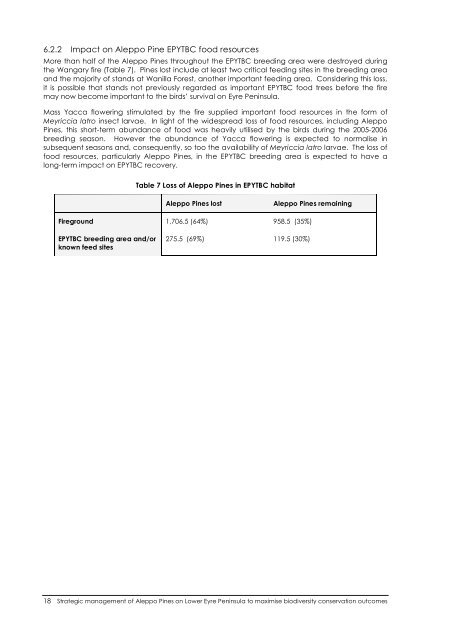Strategic management of Aleppo Pines on Lower Eyre
Strategic management of Aleppo Pines on Lower Eyre
Strategic management of Aleppo Pines on Lower Eyre
Create successful ePaper yourself
Turn your PDF publications into a flip-book with our unique Google optimized e-Paper software.
6.2.2 Impact <strong>on</strong> <str<strong>on</strong>g>Aleppo</str<strong>on</strong>g> Pine EPYTBC food resources<br />
More than half <str<strong>on</strong>g>of</str<strong>on</strong>g> the <str<strong>on</strong>g>Aleppo</str<strong>on</strong>g> <str<strong>on</strong>g>Pines</str<strong>on</strong>g> throughout the EPYTBC breeding area were destroyed during<br />
the Wangary fire (Table 7). <str<strong>on</strong>g>Pines</str<strong>on</strong>g> lost include at least two critical feeding sites in the breeding area<br />
and the majority <str<strong>on</strong>g>of</str<strong>on</strong>g> stands at Wanilla Forest, another important feeding area. C<strong>on</strong>sidering this loss,<br />
it is possible that stands not previously regarded as important EPYTBC food trees before the fire<br />
may now become important to the birds’ survival <strong>on</strong> <strong>Eyre</strong> Peninsula.<br />
Mass Yacca flowering stimulated by the fire supplied important food resources in the form <str<strong>on</strong>g>of</str<strong>on</strong>g><br />
Meyriccia latro insect larvae. In light <str<strong>on</strong>g>of</str<strong>on</strong>g> the widespread loss <str<strong>on</strong>g>of</str<strong>on</strong>g> food resources, including <str<strong>on</strong>g>Aleppo</str<strong>on</strong>g><br />
<str<strong>on</strong>g>Pines</str<strong>on</strong>g>, this short-term abundance <str<strong>on</strong>g>of</str<strong>on</strong>g> food was heavily utilised by the birds during the 2005-2006<br />
breeding seas<strong>on</strong>. However the abundance <str<strong>on</strong>g>of</str<strong>on</strong>g> Yacca flowering is expected to normalise in<br />
subsequent seas<strong>on</strong>s and, c<strong>on</strong>sequently, so too the availability <str<strong>on</strong>g>of</str<strong>on</strong>g> Meyriccia latro larvae. The loss <str<strong>on</strong>g>of</str<strong>on</strong>g><br />
food resources, particularly <str<strong>on</strong>g>Aleppo</str<strong>on</strong>g> <str<strong>on</strong>g>Pines</str<strong>on</strong>g>, in the EPYTBC breeding area is expected to have a<br />
l<strong>on</strong>g-term impact <strong>on</strong> EPYTBC recovery.<br />
Table 7 Loss <str<strong>on</strong>g>of</str<strong>on</strong>g> <str<strong>on</strong>g>Aleppo</str<strong>on</strong>g> <str<strong>on</strong>g>Pines</str<strong>on</strong>g> in EPYTBC habitat<br />
<str<strong>on</strong>g>Aleppo</str<strong>on</strong>g> <str<strong>on</strong>g>Pines</str<strong>on</strong>g> lost <str<strong>on</strong>g>Aleppo</str<strong>on</strong>g> <str<strong>on</strong>g>Pines</str<strong>on</strong>g> remaining<br />
Fireground 1,706.5 (64%) 958.5<br />
EPYTBC breeding area and/or<br />
known feed sites<br />
(35%)<br />
275.5 (69%)<br />
119.5 (30%)<br />
18 <str<strong>on</strong>g>Strategic</str<strong>on</strong>g> <str<strong>on</strong>g>management</str<strong>on</strong>g> <str<strong>on</strong>g>of</str<strong>on</strong>g> <str<strong>on</strong>g>Aleppo</str<strong>on</strong>g> <str<strong>on</strong>g>Pines</str<strong>on</strong>g> <strong>on</strong> <strong>Lower</strong> <strong>Eyre</strong> Peninsula to maximise biodiversity c<strong>on</strong>servati<strong>on</strong> outcomes

















